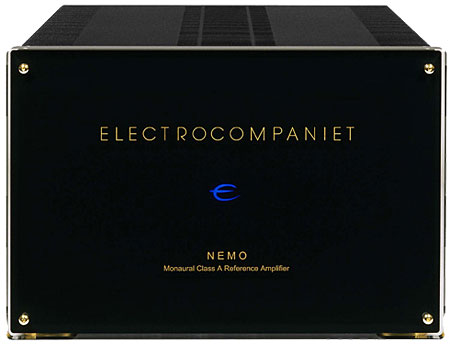| Columns Retired Columns & Blogs |
Electrocompaniet Nemo monoblock power amplifier
In his 20,000 Leagues Under the Sea, Jules Verne presents the enigmatic Captain Nemo, commander of the great submarine Nautilus, as powerful, charismatic, and mysterious. On first meeting Nemo, the narrator, M. Aronnax, notes, "I made out his prevailing qualities directly: self-confidence—because his head was well set on his shoulders, and his black eyes looked around with cold assurance; calmness—for his skin, rather pale, showed his coolness of blood; energy—evinced by the rapid contraction of his lofty brows; and courage—because his deep breathing denoted great power of lungs." All in all, "this man was certainly the most admirable specimen I had ever met."

Per Abrahamsen, designer of the Electrocompaniet Nemo monoblock power amplifier, chose its name well. The Nemo is powerful and mysterious. Its rating of 1200W continuous into 4 ohms with a peak current rating of 150 amperes makes it the most powerful amplifier I have met. Powered up, the large, bright blue company logo shone forth brightly against the black faceplate, and inspired in me the same admiration and questions that Aronnax had for the Nautilus's captain.
It's my belief—not confirmed by Abrahamsen—that the Nemo was designed to complement the B&W Nautilus 801. Wes Phillips, in his review of this loudspeaker (Vol.22 No.1, pp.107–115), found that he required four channels of topnotch amplification to drive it. However, the output of one Nemo should be sufficient to drive one full-range 801, and Nemos are put to that very purpose at Abbey Road Studios in England.
I also was impressed with the Nemo's sound when I heard it driving Alón Circe loudspeakers at HI-FI '99. Soon after, I arranged a review with Alan Warshaw of Jason Scott Distributing, Electrocompaniet's US importer.
Design
The Nemo is Electrocompaniet's flagship product. A large, imposing block of an amplifier, it is out of keeping with the rest of the company's products, most of which are light and small. The Nemo's power is commensurate with its size, and is testimony to its designer's belief that one cannot have too much headroom in an amplifier. During his time working in recording studios, Per Abrahamsen discovered that, "apart from good musicians," dynamic range was the single most important factor for good recording and reproduction. To have enough power for "extreme transients," an output of 500W is the minimum.
Abrahamsen believes that making stereo amplifiers of more than 300W output presents design challenges because the high mains voltage that must be used affects the long-term reliability of parts. The bridging circuits typically found in stereo amplifiers simply join the outputs of two channels, involving output stages that were not designed to be run bridged. The sonic results of connecting two audio amplifiers sharing a common power supply may not be good. The main advantage of bridging—much greater headroom—can be diminished in a poor design because of the increased current distortion.
Abrahamsen therefore built the Nemo as a fully symmetrical balanced amplifier, with positive and negative inputs having identical AC and DC impedance and transfer characteristics. The Nemo's design is based on that of the company's MW180, a fully balanced monoblock that operates in a balanced/bridged configuration. The power supply is fully symmetrical, using Electrocompaniet's Floating Transformer Technique (FTT). This employs separate transformers and capacitors for each amplifier on either side of the bridge.
The Nemo's top panel is secured with 16 stainless-steel, hex-head machine screws. Removing it reveals a showcase of superb construction and high-quality components. There is almost no point-to-point wiring. Two printed-circuit boards are mounted parallel, and run from front to back (see photo below). These boards contain all components, including four heatsinks, regulators, drivers, and output transistors.
Starting from the front panel and working back: Each amplifier's power transformer is set in a 6.5"-square chrome container, directly behind which is each MW180's main board, its front section occupied by six 10,000µF filter capacitors and a pair of regulators. Two 6" by 7" heatsinks sit at the back of this main board, covered on the inside by output boards. Two plastic-enclosed relays are mounted on each amplifier's main board.
- Log in or register to post comments




































